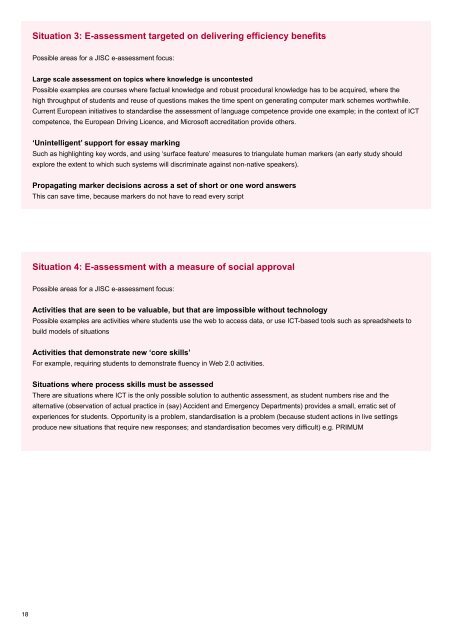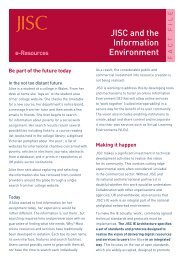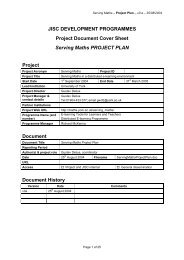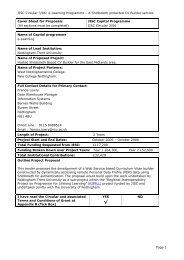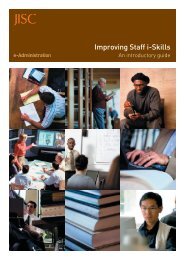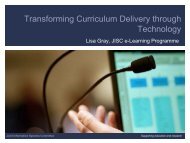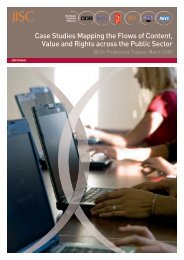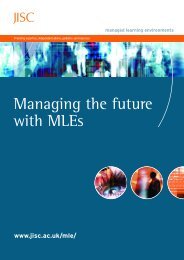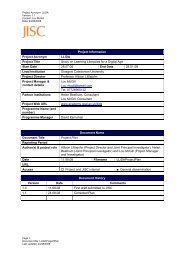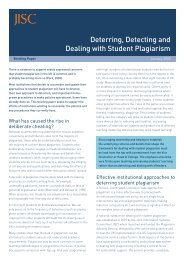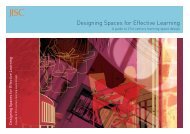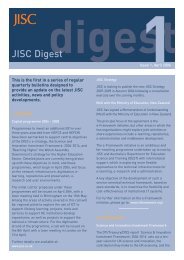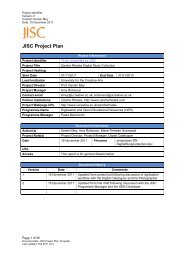Review of Advanced e-Assessment Techniques (RAeAT) Final ... - Jisc
Review of Advanced e-Assessment Techniques (RAeAT) Final ... - Jisc
Review of Advanced e-Assessment Techniques (RAeAT) Final ... - Jisc
Create successful ePaper yourself
Turn your PDF publications into a flip-book with our unique Google optimized e-Paper software.
Situation 3: E-assessment targeted on delivering efficiency benefits<br />
Possible areas for a JISC e-assessment focus:<br />
Large scale assessment on topics where knowledge is uncontested<br />
Possible examples are courses where factual knowledge and robust procedural knowledge has to be acquired, where the<br />
high throughput <strong>of</strong> students and reuse <strong>of</strong> questions makes the time spent on generating computer mark schemes worthwhile.<br />
Current European initiatives to standardise the assessment <strong>of</strong> language competence provide one example; in the context <strong>of</strong> ICT<br />
competence, the European Driving Licence, and Micros<strong>of</strong>t accreditation provide others.<br />
‘Unintelligent’ support for essay marking<br />
Such as highlighting key words, and using ‘surface feature’ measures to triangulate human markers (an early study should<br />
explore the extent to which such systems will discriminate against non-native speakers).<br />
Propagating marker decisions across a set <strong>of</strong> short or one word answers<br />
This can save time, because markers do not have to read every script<br />
Situation 4: E-assessment with a measure <strong>of</strong> social approval<br />
Possible areas for a JISC e-assessment focus:<br />
Activities that are seen to be valuable, but that are impossible without technology<br />
Possible examples are activities where students use the web to access data, or use ICT-based tools such as spreadsheets to<br />
build models <strong>of</strong> situations<br />
Activities that demonstrate new ‘core skills’<br />
For example, requiring students to demonstrate fluency in Web 2.0 activities.<br />
Situations where process skills must be assessed<br />
There are situations where ICT is the only possible solution to authentic assessment, as student numbers rise and the<br />
alternative (observation <strong>of</strong> actual practice in (say) Accident and Emergency Departments) provides a small, erratic set <strong>of</strong><br />
experiences for students. Opportunity is a problem, standardisation is a problem (because student actions in live settings<br />
produce new situations that require new responses; and standardisation becomes very difficult) e.g. PRIMUM<br />
Appendix Three:<br />
Questions for individuals and departments to use<br />
when making decisions about investing resources in<br />
e-assessment<br />
Impact on teaching and learning:<br />
• Does it solve a problem you know you have got?<br />
• What are the potential benefits and downsides?<br />
• Will it makes life more interesting and more fun for everyone?<br />
• Will it makes life easier, overall?<br />
• Do key constituencies (students, colleagues in the<br />
department, in related departments in other universities,<br />
in your own university, external examiners, university<br />
administration and management) believe that this is the right<br />
direction <strong>of</strong> travel?<br />
• What are the potential benefits for teaching and learning?<br />
• Is it easy to re-use tasks/tests?<br />
• Is it easy to add new content, change what is there, etc,<br />
choose what to present?<br />
• Can it be used for other purposes?<br />
• Is it robust?<br />
• Is it vulnerable to plagiarism? Are there facilities for detecting<br />
cheating and plagiarism?<br />
Systems issues:<br />
• What are the implications for the assessment system as a<br />
whole?<br />
Barriers:<br />
• Are there any obvious barriers to widespread<br />
implementation?<br />
• How flexible is the proposed system?<br />
• How much/what sort <strong>of</strong> staff training is required?<br />
• Training to use the system<br />
• Authoring: creation <strong>of</strong> items and tests and modifications<br />
• On-line marking time<br />
Set up costs:<br />
• What does it take to get started (in terms <strong>of</strong> expertise, set up<br />
time)?<br />
• How easy is it to set up for each wave <strong>of</strong> assessment?<br />
• How much time is involved in maintaining the working<br />
system?<br />
Impact on teaching and learning:<br />
• Is there evidence from other institutions?<br />
• What are the potential benefits, and potential threats?<br />
Risks:<br />
• What are the risks?<br />
• What are the costs?<br />
• What are the threats to the organisation?<br />
Market issues:<br />
• How big is the potential demand for this sort <strong>of</strong> assessment?<br />
• What is its strategic importance?<br />
• Are student numbers expected to rise in this area?<br />
• Are there issues <strong>of</strong> quality assurance that need to be<br />
resolved<br />
What is the evidence base?<br />
• Where has this application been used successfully?<br />
• How well does that context fit your own context?<br />
• What is the extent <strong>of</strong> the current use <strong>of</strong> the application being<br />
considered?<br />
• What evidence is there on desirable and undesirable impact?<br />
Adoption:<br />
• To what extent has it rolled out within the originating<br />
institution?<br />
• Has use extended beyond the originating institution to other<br />
institutions?<br />
• Are further generalisations plausible?<br />
Dilution and corruption:<br />
• What will systems look like when they are being used by<br />
people who did not invent them?<br />
18<br />
19


